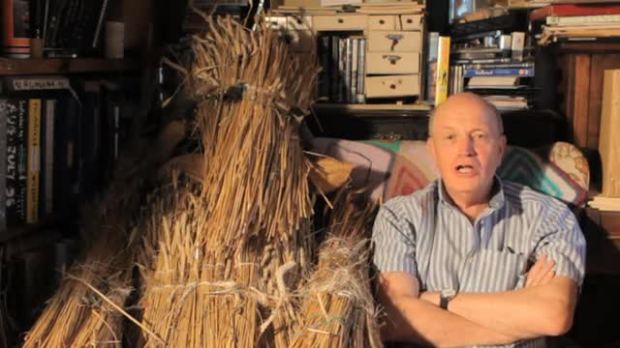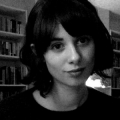You have no items in your cart. Want to get some nice things?
Go shopping
John Clare is a minor nature poet who went mad. So intones – forgive the cliché; there’s no other word for it – Iain Sinclair, who is standing in a goat mask by the side of a screen. Opposite him, a table laid with foliage and bric-à-brac is manned by two men in masks, who play water glasses and pipes from their stall. The air is of a psychotropic Animals of Farthing Wood, or a school play directed by William Burroughs. On the screen itself, we can see John Clare walking across fields and through woods. He is walking from the asylum.
It was in the summer of 1841 that Clare absconded from High Beech asylum in Essex. The walk was for home: a helplessly confused Odysseus, Clare believed he would encounter his first love, Mary Joyce. Indeed, he believed himself married to her; reports of her death in a house fire three years’ prior had not convinced him. As a patient, he had been rewriting the poems of Lord Byron, in a relationship more fraught than even the usual one between poet and influence. When questioned by an editor, Clare responded: “I’m John Clare now. I was Byron and Shakespeare formerly.” (His doctor wrote that madness came “after years of poetical prosing”, which seems unfair.) By Our Selves is Sinclair’s response – or, more properly, one of his responses – to the walk. Somewhere between a film and a performance event, it is exemplary Sinclair, and not just because the piece is structured around a journey.
The fit of Clare’s walk to Sinclair’s practice is so close that By Our Selves might be thought inevitable, and it often feels as though the latter writer has simply taken up the mantle of the former’s practice. Sinclair picks up strands of Clare’s logic which are carried into a future he did not live to see. A lit anachronistic typewriter is on stage as if in support of this; as explanation, if not justification, Sinclair suggests the rattling of bones Clare hallucinated in the woods “seemed to anticipate” the machine, on which he occasionally types. In one scene, the typewriter also appears on film, squatted beside Clare as he rests on a bowed bough. It is part of a general thread of literary confusion which By Our Selves extends both ways. When Sinclair walked the route Clare took, he noted a link to Beckett, who once visited Lucia Joyce in the Northampton asylum to which Clare was later admitted. She is buried in the same graveyard as the poet. This is what Sinclair calls a “codex of madness and possession. Old magick is the new physics”.
Still; there is something less mystical at work. By Our Selves is peppered with the sort of intertextual links Joyce’s novelist father would be wise to. In one scene Clare sees his blue plaque hung on a wall. He stares at it, seeming not to understand why it might be there but not wholly unnerved. (Not for this crowd the cheap emotional payoff of Van Gogh weeping in an exhibition of his works, as used to admittedly memorable effect in Doctor Who.) As he looks up at his name, Sinclair intones (again) the word Byron; Byron. It sounds like a canticle of school textbook poetry. Other references are more oblique: “the forest”, we are told, “was full of noises”, a choice of words which not only echoes The Tempest but also its re-appropriation in the opening ceremony of the London Olympics, on occasion Sinclair covered extensively. Sinclair names Clare a “Fenland translation of Jekyll and Hyde”; his eyes, he says, are eggs, in a nod to another mad writer, Georges Bataille. In one scene, some instrument soundtracks the film. It could be Coleridge’s dulcimer if the listener was so inclined.
Enjoyable as reference safari is, though, it’s nothing new; more notable is the purpose it serves here. For By Our Selves is about the process of reading Clare as much as – if not more than – it is about the poet himself. When, at one point in the performance, Sinclair says “John Clare is a man unpacked”, it feels like a cipher. Reading the work of a poet is always to take their constituent parts and re-invent them; that much the first year of any undergraduate English degree will tell you. Sinclair’s particular brand of chromatography is a subtle one, however, and Clare’s madness suits it well, if only for the sheer quantity of material. Alongside the literary references, By Our Selves conjures physical manifestations of Clare’s visions. The goat man which the poet claimed to see in the woods is played by Sinclair himself, wearing a plastic mask alternately over his face and on the top of his head (that one of the foremost living writers in – and of – London is wearing the sort of thing generations of children have bought from Early Learning Centre is, incidentally, deeply charming). A band of “gypsies” Clare was caught up with are represented by one of the masked instrumentalists who, wearing an orange jumpsuit like a Guantánamo convict or an industrial cleaner, is festooned with ribbons.
The specifics of this symbolism scarcely bear thinking about, but as By Our Selves goes on the symbols mount up. A small squeezebox is played on the fields. A boom mic fashioned from a long bough is held by a sound man as he walks alongside the on screen Clare. This is the detritus we get when the age of mechanical reproduction forces itself into the past, when the present collapses into the mind of a madman-poet who never saw it. It’s hard to decide if Benjamin is spinning or singing in his grave.
Other things are similarly baffling, although always enjoyably so. By Our Selves’ performance is tight and well-timed, but portions of it seem deliberately amateurish: the masked men, for instance, tug at their headgear awkwardly to put instruments in their mouths. Giorgio Agamben and composer Simon Steen-Anderson agree that play is at the heart of challenging convention, and this performance takes it to heart. Yet it also has a choreographed quality that prevents it from being irreverent. It’s hard to tell where exactly it intends to fall. Rather than being clumsy, however, the feeling is of being deliberately thrown off balance. As with the time-slips, the failing mind makes itself known as the audience attempt to get to grips: for what is madness if not an inability to discern the status of the world around you, or know how seriously to take what you see?
Two more characters stand out. One we might have expected to turn up at some point, given the purpose of Clare’s walk, but it is still dramatic when she does. Mary Joyce emerges in period clothes to the sound of a violin bow dragged over a cymbal, and advances to the piano where she begins a simple melody. If By Our Selves nods to Benjamin, then Joyce’s presence on stage is Ophelia qua Jacques Derrida, the other twentieth century figure whose work is currently enjoying widespread popularity. Not that her role is just fashionable quotation. Aptly, Joyce’s part might be divided into three acts: following the piano portion, she is made to ventriloquise the poet who mourns her, as Sinclair feeds her lines. She, too, is in a poetic tradition, forged most precisely by Edgar Allen Poe (“the death of a beautiful woman is, unquestionably, the most poetical topic in the world”) but begun before him, and continued after – Humbert Humbert’s original girlchild, herself a gesture to Poe, might be the apotheosis. When Joyce comes to her third part and is given, at least, some Burns to sing, she seems to gain strength. But this, too, circles back to Clare: his heart has, like Rabbie’s in the Highlands, been left elsewhere.
The second figure dwells closer to home. In fact, it is tied (literally) to Clare himself, being a transfiguration of the poet, who leaves one frame human and enters the next encased in wheat. This new persona – a John Barleycorn of the summer fields – continues his walk through modern England. He steps over viaducts and hovers outside Topshop, looking no more lost than a festival goer or indeed Morris dancer does. What happens next is more curious: Clare proper reappears, walking the Barleycorn behind him like a reluctant hound. The temptation for armchair Freud is palpable, but it seems too easy to say the wheatsheaf man is Clare’s externalised id. Equally, it is both something more and less than a manifestation of the English countryside, a pastoral conscience (much as the idea of John Barleycorn as muse works; see Carol Ann Duffy). Whatever it is, though, Clare eventually gives up on it, and leaves the man where he belongs, out among the corn. Or so it seems: later, Wheatsheaf comes out of the darkness and dances before the audience, to the rhythm of a drum that the Guantánamo Morris dancer yields simultaneously on stage and screen. This, too, is playful, but there is something being requested here of Englishness, also; a demand for its more arcane roots to be shown. The drummer has the face of a Pierrot.
In the end, strangeness adds up beyond its parts. By the close of his four-day walk, Clare had eaten grass from the roadside and was hallucinating. It is a grim thing for a man to do, and not to be rose (or wheat) tinted, however much certain spheres of popular discourse reward the romance of the poet-madman. Yet there is something generative to be found in Clare’s madness, just as there is something lost in looking directly at things better seen aslant. Sinclair’s slight of hand is to show them, even as he tells. From another nature writer, Patrick Kavanagh:
I have what every poet hates in spite
Of all the solemn talk of contemplation.
Oh, Alexander Selkirk knew the plight
Of being king and government and nation.
A road, a mile of kingdom, I am king
Of banks and stones and every blooming thing.
There is a danger in mastery quite as potent as that in ignorance. For all the forthrightness with which the poetic canon is handed down – John Clare was a minor nature poet who went mad – the poet contains qualities only visible from the corner of one’s eye. A reader of James Joyce, Sinclair must have spotted the homophonic resonance of his longer name. But if this is Clare turned upside down, the heart of its inquiry is pure: how do we come to know ourselves? The performance ends with the Barleycorn and Mary Joyce waltzing together, her hands pressed against the wheat. The music bids adieu to old England. Clare was good at endings. It is the first verse of “I Am” – composed in the asylum – that is quoted most often, but its last, in this case, has more to say:
I long for scenes where man has never trod;
A place where woman never smil’d or wept;
There to abide with my creator, God,
And sleep as I in childhood sweetly slept:
Untroubling and untroubled where I lie;
The grass below–above the vaulted sky.
By Our Selves has its final performance tonight at the Whitechapel Gallery.





